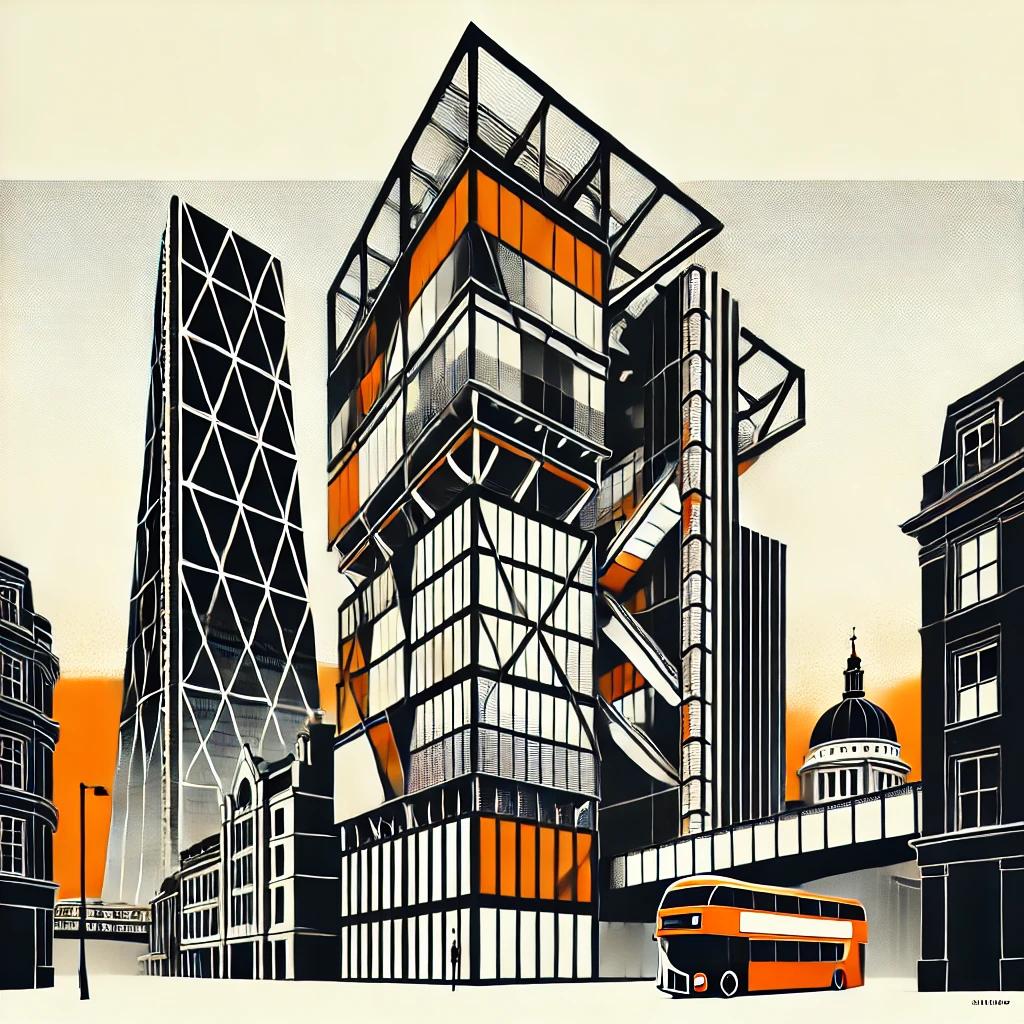Richard Rogers
Richard Rogers was one of the most influential architects of the modern era, renowned for his pioneering approach to high-tech architecture. Born in Florence in 1933, he moved to England with his family and later studied at the Architectural Association in London before completing his education at Yale University. It was at Yale that he met fellow architect Norman Foster, and together they would play a crucial role in shaping contemporary architecture.
Rogers first gained widespread recognition with the Pompidou Centre in Paris, designed in collaboration with Renzo Piano. Completed in 1977, the building turned conventional design on its head by exposing its structural elements, services, and circulation systems on the exterior. This radical approach not only defined the high-tech movement but cemented Rogers’ reputation as an architect unafraid to challenge traditional norms.
In the UK, one of Rogers’ most significant works was the Lloyd’s Building in London. Completed in 1986, it features an innovative inside-out design similar to that of the Pompidou Centre. With its external lifts, ducts, and service elements, the Lloyd’s Building embodies his philosophy of flexible and adaptable spaces. It remains a landmark of modern architecture and was awarded Grade I listed status in 2011, making it the youngest building to receive such protection.
Rogers was also instrumental in designing the Millennium Dome, now known as The O2, which was built to mark the turn of the century. Despite initial controversy surrounding its cost and purpose, the structure has since become a highly successful entertainment venue. Other notable projects include Terminal 5 at Heathrow Airport, the Senedd in Cardiff, and the Leadenhall Building, often referred to as the ‘Cheesegrater.’
Beyond his architectural achievements, Rogers was a passionate advocate for urban regeneration, sustainability, and social responsibility. His 1995 report Towards an Urban Renaissance influenced urban planning policy in the UK, promoting dense, mixed-use developments and pedestrian-friendly cities. He also served as an adviser to the British government on urban issues and was a vocal supporter of public spaces and sustainable city planning.
He was knighted in 1991 and later made a life peer as Baron Rogers of Riverside. In 2007, he received the Pritzker Prize, architecture’s highest honour, in recognition of his visionary work and lasting impact on the built environment.
Richard Rogers passed away in 2021, leaving behind a legacy of bold, forward-thinking design. His influence can be seen in cityscapes across the world, where his commitment to innovation, flexibility, and social responsibility continues to shape the way buildings are conceived and experienced.
Articles about Richard Rogers on Designing Buildings include:
- 3 World Trade Center.
- 8 Chifley.
- 88 Wood Street.
- Antwerp Law Courts.
- BBVA Bancomer headquarters.
- Billingsgate Market.
- Bordeaux Law Courts.
- British Library extension.
- Cancer Centre at Guy's Hospital.
- Centre Pompidou.
- Channel Four Television Headquarters.
- Conservation and storage facility for the Musée du Louvre.
- European Court of Human Rights.
- Heathrow Terminal 5.
- Inmos Microprocessor Factory.
- International Spy Museum.
- International Towers Sydney.
- Leadenhall Building.
- Lewisham Ladywell Temporary Housing.
- Lloyd's of London.
- Lloyd's Register.
- Macallan Distillery and Visitor Experience.
- Madrid Barajas Airport.
- Maggie's Centre.
- McArthurGlen Designer Outlet Ashford.
- Millennium Dome.
- National Assembly for Wales.
- NEO Bankside.
- Nuovo Centro Civico - Scandicci.
- One Hyde Park.
- One Park Taipei.
- Richard Rogers - A Place for all People
- Richard Rogers in conversation at Somerset House
- Richard Rogers wins the AIA 2019 Gold Medal
- Richard Rogers wins the AIA 2019 Gold Medal.
- Rogers Stirk Harbour + Partners celebrates 10 years of practice.
- Skyfarm.
- Snowfall at the Berkeley.
- Taiwan Taoyuan International Airport Terminal 3.
- Thames Wharf Studios.
- Y Cube.
Featured articles and news
One of the most impressive Victorian architects. Book review.
RTPI leader to become new CIOB Chief Executive Officer
Dr Victoria Hills MRTPI, FICE to take over after Caroline Gumble’s departure.
Social and affordable housing, a long term plan for delivery
The “Delivering a Decade of Renewal for Social and Affordable Housing” strategy sets out future path.
A change to adoptive architecture
Effects of global weather warming on architectural detailing, material choice and human interaction.
The proposed publicly owned and backed subsidiary of Homes England, to facilitate new homes.
How big is the problem and what can we do to mitigate the effects?
Overheating guidance and tools for building designers
A number of cool guides to help with the heat.
The UK's Modern Industrial Strategy: A 10 year plan
Previous consultation criticism, current key elements and general support with some persisting reservations.
Building Safety Regulator reforms
New roles, new staff and a new fast track service pave the way for a single construction regulator.
Architectural Technologist CPDs and Communications
CIAT CPD… and how you can do it!
Cooling centres and cool spaces
Managing extreme heat in cities by directing the public to places for heat stress relief and water sources.
Winter gardens: A brief history and warm variations
Extending the season with glass in different forms and terms.
Restoring Great Yarmouth's Winter Gardens
Transforming one of the least sustainable constructions imaginable.
Construction Skills Mission Board launch sector drive
Newly formed government and industry collaboration set strategy for recruiting an additional 100,000 construction workers a year.
New Architects Code comes into effect in September 2025
ARB Architects Code of Conduct and Practice available with ongoing consultation regarding guidance.
Welsh Skills Body (Medr) launches ambitious plan
The new skills body brings together funding and regulation of tertiary education and research for the devolved nation.
Paul Gandy FCIOB announced as next CIOB President
Former Tilbury Douglas CEO takes helm.























